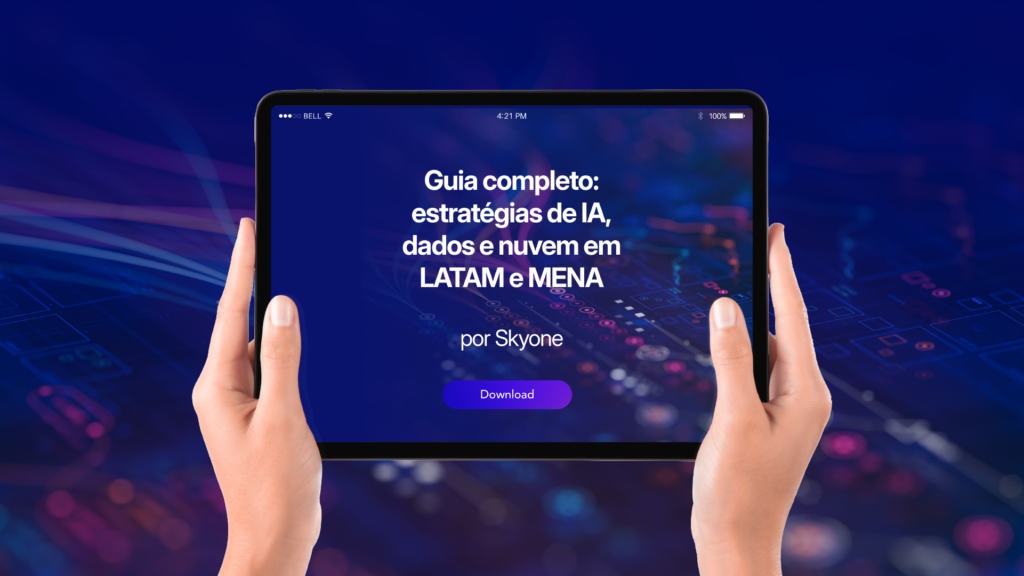Introduction
Imagine a race car in full test, cutting milettrically based on real -time data from cockpit , sensors and telemetry. Now change the track for corporate environments and pilots for systems that operate critical decisions - this is the Universe of Workflows with Artificial Intelligence (IA).
In a scenario where efficiency, scalability and operational intelligence are slogans, companies have been looking for ways to connect data, integrate systems, and automate decisions with precision and security. intelligent workflows come in , and governed data to transform processes from start to finish .
More than automating tasks, these flows learn, adapt and operate with autonomy, supporting teams in solving complex problems, with agility and strategy. For organizations that want to go beyond digitization, they represent a new phase of corporate productivity .
IBM's AI in Action 2024 report , leading companies in the adoption of artificial intelligence start from four pillars: strategy, tools, data management and practical application in central processes. This shows that the value of AI is not only in its technological capacity, but in the way it is orchestrated and integrated into the real flow of business decisions.
And it is exactly where workflows , not as an abstract promise, but as practical instruments for transforming the operation and accelerating decisions with intelligence.
In this article, we will start a journey through the integration of workflows , and reach automated and strategic decision making. Tighten the belts!
What are smart workflows
Think of a Formula 1 team adjusting the car during the race, based on car, track and climate data. It is this kind of precise, dynamic and connected coordination that workflows seek to bring to the corporate environment.
Instead of following fixed and repetitive instructions, they operate as context -reacting systems, learn from data and help companies make better decisions - all with more autonomy and less manual intervention.
These flows stand out for their ability to understand what is happening in the process, adapt the execution as needed and ensure that each step is aligned with the ultimate goal. They are like an “operational brain” integrated with the business routine.
To understand why this approach represents an important change , it is worth comparing with traditional models.
The difference between traditional and intelligent workflows
Traditional workflows act as fixed checklists : each step depends on the previous one, and any deviation requires manual reconfiguration. Smarts are more like adaptive systems : if something changes, the flow knows how to adjust.
| Traditional Workflow | Workflow with AI | |
| Flow | Linear, rigid | Flexible and contextual |
| Rules | Static | Based on data and objectives |
| Adjustment | Manuals | Automated |
| Focus | Repetitive execution | Strategic and Responsive Delivery |
This leap of capacity allows more agility and operational resilience , two factors that have become essential in more dynamic and data -oriented business environments.
Why are workflows gain space in companies
Companies that seek to scale their processes more intelligently have realized that only automating is not enough. You need to understand, decide and act with context .
Therefore, workflows are gaining space, since:
- They reduce the time between event and response;
- Bring more clarity and fluidity in the execution of processes;
- They allow technology to follow the pace of business , without locking into the rigidity of fixed rules.
More than fad, this approach represents a new way of operating, more connected, strategic and prepared to deal with the actual complexity of organizations.
In the next section, we will explore better how AI agents enter this equation and make these flows even more powerful.
How do Workflows with AI agents?
Smart work flows operate as a well -trained team behind the scenes of a professional race. Each component has a clear function, acts with autonomy and connects with the others to ensure that everything follows at the right pace.
Behind the scenes, who fulfills this role is AI agents. These agents act as specialized digital operators , who understand what needs to be done, analyze data in real time and make decisions based on previously defined goals.
Unlike a system with fixed rules, here the process is alive : agents learn from history, recognize patterns and fit the context - all while the flow continues to run. They can:
- Identify exceptions and act to solve them without stopping the process;
- Search for information from internal sources (such as the ERP of the company) to validate actions;
- Prioritize steps based on urgency or impact, always focusing on the ultimate goal.
It is important to remember that this distributed structure only works when the company's database is well connected, safe and governed . This is what allows agents to act clearly and responsibly, without depending on manual commands with each step.
It's like having a team of engineers following every lap of the race, adjusting the strategy according to the performance, climate and signs of the car. The result: smarter, resilient and strategically aligned flows in what the company wants to achieve.
Next, we will explore how these agents, when orchestrated in a coordinated manner, lead to flows to an even more sophisticated level of autonomy.
AI orchestration: When flows become autonomous
A Formula 1 car doesn't just win because it has good riders or cutting -edge technology. It wins when there is perfect sync between all systems, engineers, data and decisions , working in harmony from beginning to end of the race. With workflows , this synchrony happens through orchestration with AI.
Here, orchestrate goes beyond organizing tasks: It means coordinating autonomous agents, adjusting events based on events, and keeping the process flowing without friction, even in complex scenarios.
When a workflow reaches this level, it is no longer just a set of rules and becomes a system capable of making decisions on its own , always in line with the company's strategic objectives. Each agent understands their role, but also sees the whole, cooperating with other agents, reevaluating the way and acting focused on results, not just stages.
This coordinated autonomy is only possible when three pillars are present :
- Integrated and well -structured data that provide the right context;
- Clear objectives , which guide the decisions of agents;
- Plugable and secure infrastructure , which allows you to operate with flexibility, without locks or excessive technical dependencies.
The great gain here is strategic : with the AI orchestrating the flows, the company no longer depends on reprogramming or manual approvals to react to change. The system itself understands, decides and runs, as if it were a technical team that, in the face of a change in the track, adjusts the car in seconds without having to wait for the pitstop .
Now it's time to know which frameworks make this orchestrated intelligence possible and how they make it easier to build smart flows with multiple agents working together. Follow!
Frameworks for creating smart workflows
For flows with AI agents to work in a coordinated manner, it takes more than good components: a system that structures the logic is required, connect the points and allow everything to operate in a fluid way . This is where the orchestration
frameworks These tools help companies model complex processes clearly, defining how agents interact, what conditions they shoot actions and how decisions evolve over time. In practice, we can imagine that they function as the strategy framework of a technical team in motorsport, offering the complete view of the route and allowing accurate adjustments without stopping the race .
Nonlinear flows, conditional decisions and iteration
One of the biggest differentials of workflows is that they don't follow a fixed script. Instead of plastered processes, we have flows that adapt to reality , with branches, cycles and decisions that depend on the context of each situation. These flows are:
- Conditional : change the way according to variables such as values, business rules or user behavior;
- Iteratives : Repeat steps automatically when they detect failures or need to refine the results;
- Nonlinear: Allow agents to make decisions in parallel, return to previous steps, or create new paths without interrupting the process.
This logic is what allows us to act intelligently instead of just following instructions. Flow behaves like a living system that reacts, learns and adjusts the route to achieve the best result.
In addition to Langgraph, other approaches also make this type of structure possible. Platforms such as Apache Airflow, Prefect, and even Low-Code Automation Frameworks with conditional logic support (such as N8N and Node-Red) offer ways to build more flexible flows- each with its particularities in terms of scalability, integration and control.
The important thing here is not the tool itself, but the change of mindset : to put aside the rigid sequence and adopt a flow logic that thinks, forehead, decides and adapts.
Multiagent coordination in complex environments
As flows become more sophisticated, it is not enough to have smart agents operating in isolation . They need to work in a coordinated manner, each with its own role, but connected by a common goal . This multiagent logic allows:
As flows become more sophisticated, it is not enough to have smart agents operating in isolation . They need to work in a coordinated manner, each with its own role, but connected by a common goal . This multiagent logic allows:
- Divide responsibility between specialized agents;
- Establish information exchanges in real time;
- Create dynamics where decisions are made cooperatively, without overload on a single point of the system.
customer onboarding process One agent validates documents, another analyzes credit data, while a third structure the relationship plan. All operate in parallel, but connected by defined rules and goals. If something gets out of the standard, they reorganize, redirect or consult the human , all without waging the flow.
It is this ability to act in a coordinated, responsive, and strategic manner that makes Workflows smart scalable. They not only automate: they replicate behaviors of high performance teams , with logic, purpose and structured collaboration.
With structures such as these in operation, impacts begin to reflect on multiple areas of the business , from operation to strategic planning. Therefore, in the next section, we will explore the main benefits that workflows can bring to companies that seek more agility, intelligence and competitive advantage.
Workflows Benefits for Business
Adopting workflows is more than automating processes: it is creating a strategic gear that thinks, adapts, and delivers results accurately. They do not replace people, but expand their ability to act more focus, data and agility.
Among the main benefits we can mention:
- Efficiency with intelligence : More than cutting steps, these flows know when accelerating and when to slow down, like a team that adjusts the strategy during the race. They automate what is repetitive, but also analyze and learn from what happens in the process;
- Answer Agility : With decisions distributed between agents and based on contextual data, the time between event and action decreases dramatically. This allows you to respond to the market and customer faster and more consistency;
- Traceability and Governance : Every action taken by an agent can be monitored and explained. This strengthens compliance and ensures security in regulated environments, where decisions need to be auditable;
- Connection between areas and systems : These flows integrate data and tasks from different departments, breaking silos and promoting real collaboration, without depending on manual exchanges;
- Insights for continuous evolution : By registering patterns, exceptions, and decisions, Workflows create a rich base for future analysis. This allows you to identify bottlenecks, adjust routes and continually improve performance
Once again, it is important to emphasize : These benefits are only realized when flows are built on real data, well -integrated structures and clear goals. As with a strategic race, the differential is not only at engine power, but in the ability to read the track and adjust the rhythm with each curve !
Then, let's see the other side of the coin : What are the challenges and points of attention companies should consider to reap these results in a safe and sustainable way?
Challenges and attention points in the adoption of smart workflows
See the main factors that companies need to consider:
- Data Maturity : AI agents can only operate with quality when they have access to reliable, organized and contextual data. Companies that still depend on loose spreadsheets or systems that do not talk to each other will need to invest first in structuring;
- Integration with legacy systems : Although many frameworks and platforms are plugable, not every old system offers easy connectivity. Assessing the degree of integration and preparing reliable connectors is a key step in avoiding operational ruptures;
- Governance and Security : By automating decisions, it is essential to ensure control, traceability and clear criteria on who decides what. Without governance, the flow loses confidence - and this compromises gains;
- Culture and Organizational Alignment : Introducing intelligent flows is not just about technology. It requires engagement of business areas, clarity about objectives and a change in the way processes and decisions. When this does not happen, the project becomes another punctual automation, not a real transformation;
- Expectations Overload : Workflows with AI are powerful but not magical. It is important to align expectations: they accelerate and expand human abilities, but do not replace strategy, management or critical sense.
Seeing these points from the beginning allows adoption to happen more fluidly, with less rework and more impact .
Now, how about we dive into Skyone and understand how Skyone Studio reflects this logic into an integrated, safe and objective -oriented platform? Check it out!
Skyone Studio and his approach with smart workflows
Everything we have seen so far needs a solid base to work. This is where Skyone Studio , Skyone's new platform designed to turn corporate flows into smart, reliable and scalable systems .
Skyone Studio gathers in one structure everything companies need to create, execute and evolve smart workflows , without depending on multiple disconnected tools or makeshift solutions.
The four layers that structure Skyone Studio
Skyone Studio's architecture is organized in four complementary layers, which function as parts of a high performance car , each with its own role, but all working in sync:
- Ipaas (Intelligent Integration) : Connects over 400 systems, with hybrid integration, data transformations and workflows . It is the engine that ensures that information flows between systems, without noise;
- Lakehouse (governed data management) : centralizes, organizes and segments data in real time, ensuring quality, governance and interoperability, ie the reliable basis for any decision making;
- AI (autonomous execution) agents : Create and perform flows with private LLMs, memory, reusable skills and objective -based decisions. It is the digital operators that drive the flow as the context requires;
- Conversational Platform with BI : Allows interaction via WhatsApp, Telegram, Chat , and exports data to tools such as Metabase and Power BI, expanding access and practical use of information, with distributed intelligence.
Strategic Vision: From collection to decision on a single platform
Skyone Studio's big differential is the way it connects the ends of the data and decisions journey into one environment:
- From collection to analysis , undergoing automation, execution and monitoring;
- With plugable agents , who can operate with or without pre-formal skills;
- And with centralized control , which ensures safety, visibility and scalability throughout the operation.
With this, Skyone Studio is not just a platform : it is the infrastructure for companies that want to turn their operation with real AI. All without shortcuts, no improvisation , and with the confidence that each decision made reflects a structured, traceable and business -oriented process.
As with an elite team, where engine, tires, sensors and technical staff operate as a unit, Skyone Studio integrates all dimensions of digital operation into a “ strategic cockpit , ready for faster, safe and aligned decisions to the business track.
Want to understand how all this can work in practice? Talk to a skyone expert and start exploring the flows of the future!
Conclusion
The adoption of smart workflows marks a turn in the way companies operate, integrate technology and make decisions. More than performing tasks automatically, these flows can understand context, learn from data and collaborate to deliver consistent results , with agility and alignment to business objectives.
In this article, we go through the fundamentals that support this transformation : from the concept of workflows to their practical application with AI agents, frameworks such as Langgraph and structures like Skyone Studio. We have seen how these elements, when connected with intelligence and purpose, make it possible to build adaptive, auditable flows and capable of evolving along with the corporate environment .
Instead of plastered processes, with smart workflows companies gain autonomy, fluidity and predictability , such as a high performance car that responds to the smallest sign of the track without losing focus on destination.
Did you like this text and want to keep following the transformations that are shaping the future of business intelligence? Explore our Skyone Blog designed for those who lead the now with future vision!
FAQ: Frequently Asked Questions on Smart Workflows
Smart workflows are increasingly present in companies seeking efficiency, agility and better informed decisions . Still, it is natural that doubts arise about what these workflows are, how they work and what it takes to adopt them. Below and strategic questions
1) Do I need a technical team to implement?
Not always. With the support of the right platforms, such as workflow and configurable agents, business areas may participate in the creation of flows with minimal technical support. Complexity will depend on the desired integration and customization level.
2) Smart workflows
Yes. Most modern platforms offer hybrid integrations that allow you to connect legacy (inherited) systems to new flows without having to redo all the existing architecture. The ideal is to ensure that the data is accessible and that there are connectors or APIs available.
3) How to measure the success of an workflow ?
The success of an workflow can be measured by performance indicators, such as:
- Time reduction in key processes;
- Increased automation of repetitive tasks;
- Accuracy in data based decisions;
- Decreased rework and manual failures.
More than automation volume, the value is in the actual impact on business results.
4) Which sectors do the most benefit from these AI flows?
Sectors with high operating load, recurring decisions and large volumes of data are the ones that benefit the most. This includes:
- Financial Services (credit, compliance , service);
- Retail and e-commerce (operations, logistics, marketing );
- Industry (supply chain, maintenance);
- Health (medical record management, screening, authorizations).
The logic is simple: the more structured processes and data available, the greater the gain potential with smart workflows

LUIZ EDUARDO SEVERINO
Passionate about artificial intelligence and its real -world applications, Severino explores how AI can transform business and boost innovation. On Skyone's blog, he demystifies trends, explains advanced concepts and shows the practical impact of AI on companies. Connect with Severino on LinkedIn: https://www.linkedin.com/in/Leaddoseveneven/




